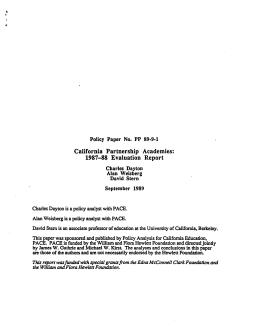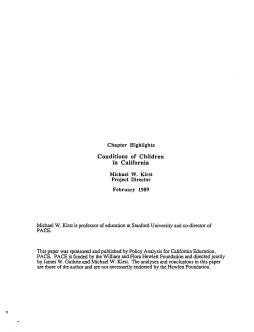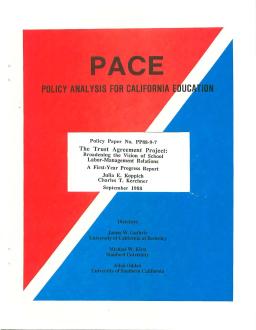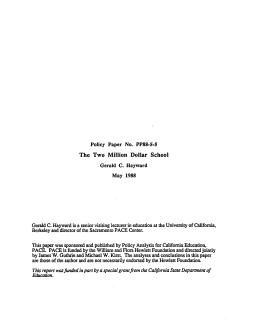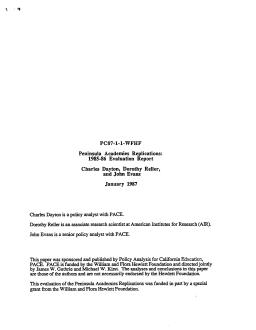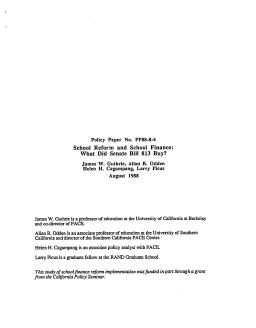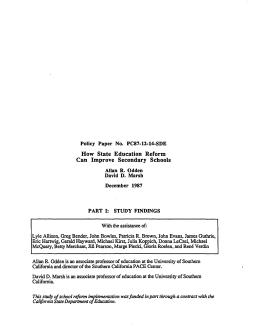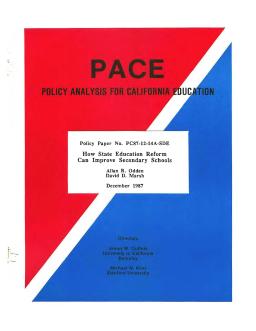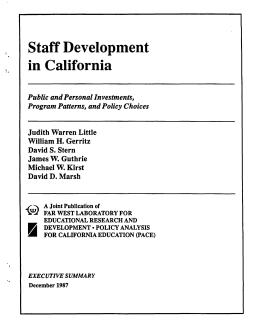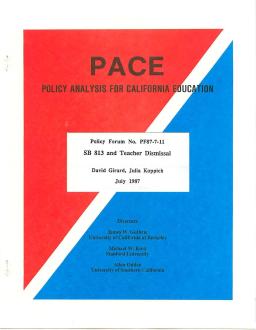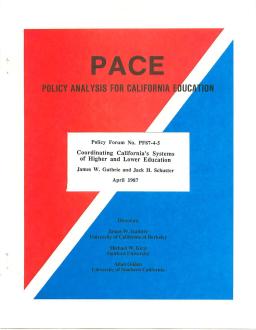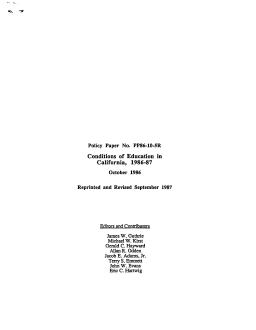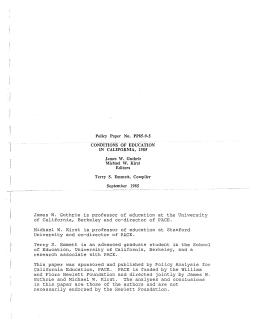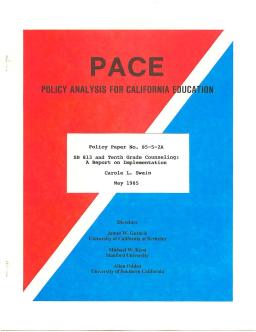1987–88 Evaluation Report
Published
Summary
This report presents findings from the third annual evaluation of Partnership Academy Programs in CA, a high school-based, state-funded program with a school-within-a-school administrative structure that enrolls at-risk students with academic potential. The program provides students with basic job skills in a promising labor-market field and support from local businesses, including curriculum development, guest speakers, field trips, mentors, and work experience positions. The evaluation addresses the quality of program implementation and the degree to which programs follow the academy model.
Chapter Highlights
Published
Summary
This report provides social indicators to evaluate the quality of life for children in California, covering physical and mental health, safety, sexual behavior, academic achievement, and the settings and systems that serve children. Despite most children being healthier and better schooled than in the past, recent polls indicate concern about child-rearing and the likelihood of an expanding educational underclass. The report aims to offer a portrait of the quality of California's children, address gaps in available data, and provide limited policy recommendations.
Broadening the Vision of School Labor-Management Relations—A First-Year Progress Report
Published
Summary
The Trust Agreement Project aimed to develop new forms of school organization and relationships among teachers and administrators. Six California school districts participated, each selecting an educational policy area for trust agreement development. Trust agreements produced role changes, fostered collaboration, and altered decision-making. These initial results show promise in leaping school districts from the 19th-century industrial model to a more appropriate 21st-century model.
Published
Summary
In 1987, the Superintendent of Public Instruction released a document detailing the average costs of California schools for 1985-86, providing a brief summary of school expenditures. However, this report lacks in detail, and this report aims to provide more comprehensive and realistic data on school expenditure patterns. The report serves as an analytical base for exploring issues surrounding school expenditures in California, and the data was provided by the state Department of Education staff.
1986–87 Evaluation Report
Published
Summary
In the fall of 1985, ten academy programs were established by the State of California as replications of the Peninsula Academies. PACE evaluated these 10 academies in 1985–86. This report presents findings from a second evaluation covering the academies' 1986–87 school year.
Published
Summary
The fourth edition of Conditions of Education in California has expanded its content to include a special features section on education reform processes, along with the previously included sections. The publication is based on compiled information from other sources and original data collection and analysis. The format has been altered to improve readability for a wide range of audiences.
Study Findings
Published
Summary
In 1983, California's Senate Bill 813 aimed to improve the education system by proposing a large number of reforms. However, it lacked a cohesive strategy and proven philosophy. The bill's impact on school districts and schools was unknown, and this study aimed to assess whether selected schools could implement the reform components and whether they contributed to school improvement. The goal was to understand how schools reacted to state mandates and inducements for improvement.
Background and Technical Appendices
Published
Summary
California's education system faced a decline in the early 1980s, prompting reforms such as a common core curriculum, higher graduation requirements, and tougher academic standards. A Nation at Risk report further pushed for nationwide school changes. California's swift response led to the enactment of Senate Bill 813, a comprehensive education reform program with over 80 policy and program reforms. Several studies showed positive results, but the study in this report aims to determine how state-level education reforms improved local schools.
Public and Personal Investments, Program Patterns, and Policy Choices—Executive Summary
Published
Summary
The California Staff Development Policy Study was initiated to assess the possibilities and limitations of staff development in improving classroom teaching and learning. The study aims to answer four questions related to California's investment in staff development, how staff development activities are administered, and how teachers and administrators judge their effectiveness. The study yields eight main conclusions, presented in terms of investment and focusing on improving the capacities and commitments of California's educators.
Published
Summary
In 1985, the Policy Analysis for California Education (PACE) convened a group of attorneys and education policy experts to discuss the effect of Senate Bill 813 on teacher dismissal. They explored varying interpretations of its provisions, contrasted practical experiences with legislative intentions, and outlined recommendations to improve the dismissal process. This summary analysis includes a brief discussion of relevant court rulings and no attempt has been made to update the information since its initial publication.
Published
Summary
California's higher and lower education systems are inadequately coordinated, resulting in negative effects on teacher quality and disruptive changes in admission requirements. The low status of teacher training in universities and the irrelevance of education research to teaching needs exacerbate the problem. Four complex policy areas require consideration: teacher preparation, admission policies, education research, and statewide education coordination. To benefit students at all levels, effective planning and coordination are critically important, extending beyond voluntary efforts.
Published
Summary
Continuing growth and sustained progress on educational reform characterize California's public schools, but the Gann spending limit, which potentially restricts state dollars for education, and projected shortages of highly qualified teachers dampen prospects for continued educational improvements. Indications of important educational progress in California, which PACE documented in Conditions of Education in California, 1985, continue on many fronts. This is particularly true when compared to the recent decade of serious decline in California's public school system.
Waivers and School-Based Program Coordination Under AB 777
Published
Summary
California's waiver authority provides school districts relief from Education Code, allowing them to seek alternatives to state requirements subject to local and state review. Waivers are automatically approved unless denied by the State Board of Education, which rarely happens over local objections. Program waivers are rare despite clamor for needed flexibility, possibly due to districts being unaware of the process, viewing it as time-consuming, or using suboptimal local procedures. Oversight hearings are recommended to explore the potential of the waiver process.
Published
Summary
This technical report provides an overview of California's educational system, intended for educators, public officials, journalists, and informed citizens. With over four million students and a $17 billion annual cost, the state's school system is vast and complex. The report offers comparisons of California's education system to itself in prior years and other states, revealing patterns of change and suggesting future trends. These trends serve as a guide for the many facts and figures presented in the report.
1982–83 to 1984–85
Published
Summary
This study examines curricular changes in California high schools from 1982-85, as educational reforms aimed to enhance academic rigor. Findings show increased offerings in academic subjects like math, science, and advanced placement, and decreased offerings in areas such as industrial arts, home economics, and business education. The data aligns with statewide curricular changes, likely influenced by mandates for more extensive graduation requirements and alterations to university entrance requirements.
A Report on Implementation
Published
Summary
Comprehensive school guidance programs attempt to address a range of student needs on personal, social, career, and academic dimensions. Many guidance and counseling programs, however, have suffered cutbacks in recent years even though students continue to be in need of guidance, and students themselves have expressed a desire for assistance.
Published
Summary
This study examines consolidation's impact on student achievement in California. It finds that consolidation leads to improved educational opportunities and cost savings. Consolidation benefits low-income and minority students and has a greater impact in rural areas. Although drawbacks exist, consolidation can be an effective strategy for enhancing education. These findings offer valuable insights for policymakers and education leaders seeking to improve student outcomes in their districts.
Published
Summary
The first in a series of annual reports on education in California aims to assess school performance objectively. It summarizes data on demography, academic performance, curriculum, personnel, and finances. Highlighting California's 1983 education reform effort, the report provides a baseline for assessing future reforms, with successive reports addressing the same dimensions. It focuses on K-12 public schools but also includes some data on nonpublic and postsecondary education.
